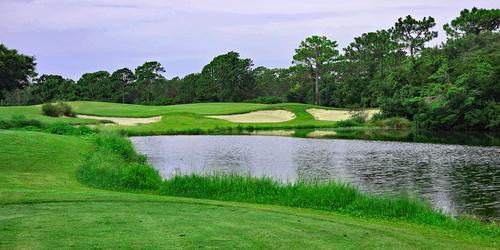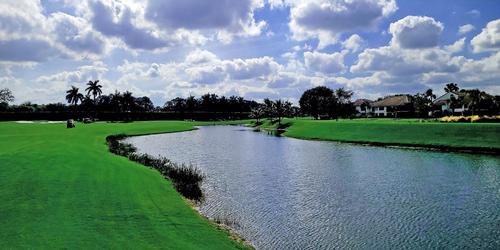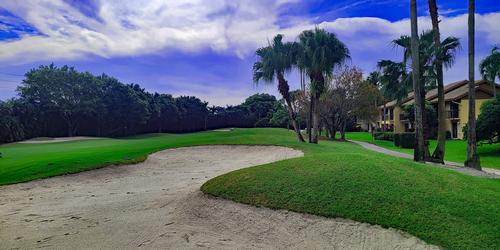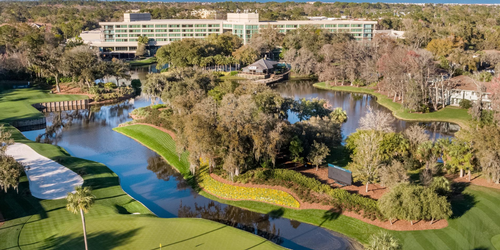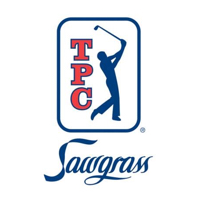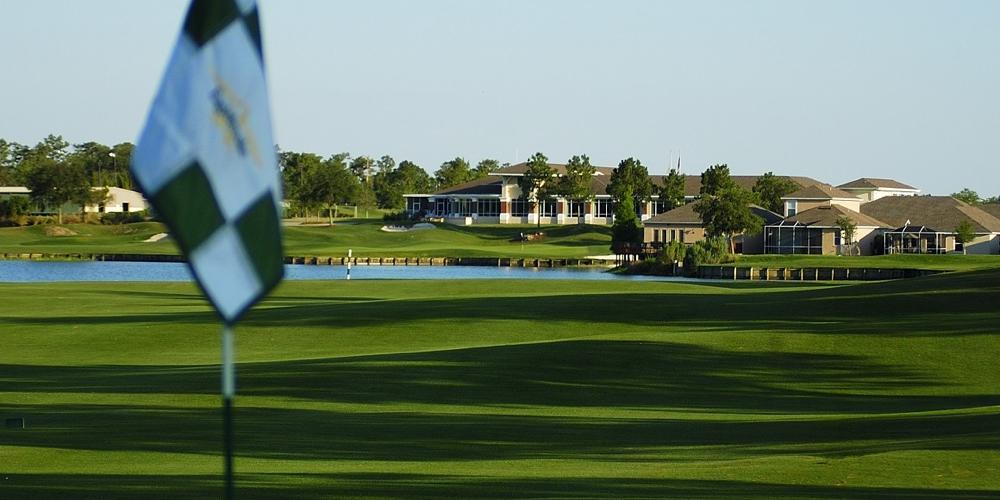
The Club at Eaglebrooke
A Polk County Hidden Gem
By David Theoret
The 18-hole Eaglebrooke course at the Club At Eaglebrooke in Lakeland, Florida features 7,005 yards of golf from the back tees and plays to a par of 72. From the back, the course rating is 74.0 with a slope rating of 136 on Bermuda grass. The course was designed by renowned architect Ron Garl and opened for play in 1996.
Eaglebrooke is located in southern Polk County, making it convenient to Orlando and the Tampa Bay area. Golf Digest consistently rates Eaglebrooke 4 1/2 stars and has designated it course as one of the Best Places to Play for the past nine years. With six sets of tees, every level of golfer from the beginner to the more experienced player will find just the right challenge. Currently semi-private, Eaglebrooke is a full service country club committed to the highest standards.
The fully stocked Golf Shop is staffed by experienced golfers ready to assist you with club selection, fitting, and lessons. You will always find the latest in apparel and accessories to meet the needs of even the most discriminating golfer. Looking to fine tune your game? Individual instruction is also available and can be arranged to fit into even the most hectic schedule. Eaglebrooke's professional team can arrange golf outings and events as well as teaching clinics held independently or combined with meetings, seminars or other banquet events.
Nestled among the oaks of southern Polk County The Club at Eaglebrooke is a gem awaiting discovery. Undulating fairways meander along bunkers and scenic lakes to multi-leveled, meticulously manicured greens, giving this championship golf course a challenging yet forgiving appeal.
Memorable Holes - (All Yardage is from Course #2)
Number 2: Par 4, 393 yards. Leave your driver in the bag on this hole! Instead, choose a fairway wood, hybrid or long iron off the tee. You only need to hit it about 210 - 220 yards. From there you will be faced with an uphill shot of about 130 - 140 yards to a green that is much wider than it is deep. Anything over the green spells trouble in the form of sand. Number 2 is the ultimate in target golf.
Number 4: Par 4, 419 yards. The amount of carry over the water from the tee box is entirely up to you; the more you bite off, the shorter your approach shot. For me the line is just left of the 150 marker. Most golfers will encounter the water again on their approach shot; some will choose to lay up on their second. A large trap guards the right side of the green, which has a lot of undulation and slopes back to front. Par is a good score here.
Number 9: Par 4, 411 yards. The most important shot you will hit on this hole is your tee shot (isn't it always)? Fairway bunkers come into play on both sides in the landing area, no matter which set of tees you play from (unless you're a scratch male golfer playing from the reds). Long and straight is good. Not much trouble awaits your approach shot; a bunker on the right could come into play. The green slopes back to front. Two good shots here will get you set for the inward nine!
Number 12: Par 3, 168 yards. Ranging in length from 149 to 189 yards for the men, this is the shortest hole on the course. There is out of bounds on the left and water on the right; neither of which should come into play. It's a fairly wide open and easy hole. That is unless you find one of the three nasty pot bunkers on the right side. They can easily ruin your round.
Number 17: Par 5, 530 yards. This is one of those holes that you will do better on each time you play the course; knowledge of the hole is everything here. If you have tremendous control of your driver and can hit a draw on command, your line is slightly right of the tree line on the left. For the rest of us, straight out toward the trees is a good line although the water could come into play if you really get a hold of one. On your layup shot, the landing zone can be pretty small with water creeping back into play on the right. The water on the right continues to come into play on your approach shot. One thing I did notice that with a pin placement on the right side, balls hit to the green on the left were funneling down to the hole. This is my favorite hole at Eaglebrooke.
Number 18: Par 4, 401 yards. This dogleg right finishing hole goes around a lake and is a fitting end to a picturesque round at Eaglebrooke. It's best to play your drive to the left of the 150 marker and take the water out of play - for now. You'll most likely encounter it again on your approach shot - or at least it will dwell in the back your mind. The sand traps behind the green really shouldn't come into play. Anything short and right will most likely find the water. The large green slopes back to front; a back pin placement can prove interesting. Number 18 is a great finishing hole.
Last Word: To start with, Eaglebrooke has a really nice practice facility; the driving range, short game area and practice putting green allow you to work on every part of your game. Many golfers come here just to practice; you can pay one price and use all areas of the practice facility all day long. There is a large, full length driving range with multiple target greens that allow you to hit every club in your bag. Next, there is a short game area complete with a large, slightly elevated putting green to chip to and bunkers to practice from as well. Lastly is the immense practice green that is always in great shape. Be sure to roll a few putts before your round and you will see how fast and true they roll.
What you will find is a course with a lot of rolling terrain. While many courses feature undulating greens, here the entire course undulates. You're likely to encounter every imaginable lie - uphill, downhill, side hill; something that is often absent from golf in Florida.
Eaglebrooke is as much a shot maker's course as it is a long baller hitter's course. Number 2 comes to mind; it requires two accurate shots to hit the fairway and the green. Pull your tee shot or hit it too far and you can easily end up in the ravine that fronts the putting surface. After a successful tee shot, hit a mid-length iron to a shallow green with sand in the back. Long ball hitters can have a huge advantage on number 4, a true risk reward hole. Bite off as much as you dare to leave yourself a shorter iron into the green.
Number 17 is a fun par 5 as well. Knowledge is key on this hole; especially knowing where to hit (or not hit) your tee shot. The green is reachable in two from just about any set of tees provided you know where to hit your tee shot. Going over the trees on the left - which really is not feasible for most - goes a long way in doing just that. Number 17 is a very picturesque hole with the water and rocks right of the green.
I dare to say that Eaglebrooke is perhaps the nicest course in the Lakeland area that is available to the public. Their rates are quite reasonable, their staff is friendly and personable and the course is usually in fantastic shape all year round. For more information, visit them online at www.eaglebrooke.com or give them a call at (863) 701-0101.
Revised: 11/14/2013 - Article Viewed 30,248 Times
- View Course Profile
About: David Theoret
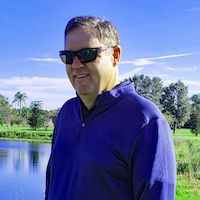 David Theoret has been in the golf and golf travel industry for over 10 years, primarily selling online advertising. For the past seven years, he has also been a golf writer, reviewing golf courses, resorts, destinations, equipment, golf apparel, and training aids - the latter of which never seems to help. David's articles and reviews have been posted on many golf travel and equipment websites.
David Theoret has been in the golf and golf travel industry for over 10 years, primarily selling online advertising. For the past seven years, he has also been a golf writer, reviewing golf courses, resorts, destinations, equipment, golf apparel, and training aids - the latter of which never seems to help. David's articles and reviews have been posted on many golf travel and equipment websites.
Growing up in Southwestern Ontario, Canada, it was naturally assumed he would play hockey. Beginning at the age of 3 and continuing into his late 30's, he did just that. However, after one too many pucks to the head, he realized that golf was a lot easier on the body (whoever said hockey players were slow) and took the game up.
After moving to Florida and accepting a position with TravelGolf Media (now part of GolfNow) his love for the game grew exponentially. Most Saturdays you will find him on a course somewhere in Florida or on the practice range reinforcing his bad habits. David plays to a 10 handicap - unless there is money involved in which case it goes considerably higher. He currently resides in Lakeland, FL with his wife Belinda and their two "kids", Madyson and Molly.
Follow David Theoret:
Contact David Theoret:
GolfTrips.com - Contributor





